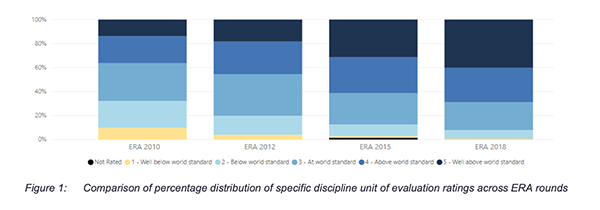by MARNIE HUGHES-WARRINGTON
The fox knows many tricks, but the hedgehog knows one big one. Classifications like this illuminate, Archilochus, and Isaiah Berlin reminded us. They highlight the ways in which we think about all kinds of things, including people who have single or multiple ideas, It also applies today, when we think about the nature and purpose of research.
A cursory glance at the Australian Research Council’s consultation paper for ERA EI—Excellence in Research for Australia and Engagement and Impact—might lead you to think that it is about many things. 98 questions lead this way and that, darting from one way of thinking about research excellence to another. But it is also about one thing, a solitary figure on page 16:

This is a big thing. It shows that research has got progressively better in Australia since 2010. The majority of research is above world class (ERA four), or well above world class (ERA five). Progress is being made.
Histories, like hedgehogs, though, have many quills. Let me use my quill to tell you another thing.
ERA is not one thing, it is two.
ERA is divided into citation analysis fields of research, and peer review fields of research. The first is used predominantly for the sciences, the latter for the humanities, arts, social sciences and creative arts. Here is a graph showing the proportion of fields rated well above world standard (ERA five) in the citation group, and the peer review group, at broad two-digit level. Even if you take the outliers out—the highest proportion of fives is found in environmental science, the lowest in creative arts—the result does not change much.

Over eight years, the proportion of fives in the citation fields grew from 17.5 per cent to 41.5 per cent. The proportion of fives in peer review fields grew between 2010 and 2012 but hovered stubbornly at or under 9 per cent after that. Repeat the exercise at the more detailed four-digit level, and the trend holds.
Quills hurt, because histories are rarely just about the past. They also incline you towards the future. Without a re-think, the self-reinforcing future of ERA will continue to be written in the citation fields, in STEMM. ERA is therefore not just two things, it is two trajectories: one accelerating, one appearing not to move at all. Fox and hedgehog, if you like.
Antilocus and Berlin told their stories not to force us to choose between two animals, but to remind us that there is more than one option. Two pasts, two presents, two futures. In combination, they are powerful.
Investment in STEMM is critical for society and the economy. But knowing just this one thing can cost you dearly. The STEMM fields are largely high cost, and as the ABS has reminded us, 56 per cent of research funding has come from universities themselves. In almost all cases, that investment comes not from somewhere, but from someone: students. In a possible future, that funding will come predominantly from students in peer-reviewed fields. The two ERAs will drive two trajectories: one headlined by research, the other by teaching. Did we intend for ERA to be this way?
Teaching and research belong together, and the HASS, creative arts and STEMM belong together for the good of society and the economy. Businesses and communities do not always lack for technical knowhow. They fail to grow and to regenerate in the absence of good planning, policy, management, communication and marketing. They also fall over due to lack of creativity, learning from past mistakes, knowledge of the people they are designed to serve, and ethics. These are not “soft skills”, these are the hard-edged realities of what it takes to flourish. Lack of innovative capability in these relatively low cost research areas will stymie the health of society and the economy.
You can ask 98 questions and you can chase your tail. You can ask one question—why are there two ERAs?—and wonder at the consequences of this split. You can understand that ERA is more about the future than the past and draw the two communities back together again to write a future for research, and for society, in diversification. Fox, and hedgehog.
Marnie Hughes-Warrington is DVC Research and Enterprise at the University of South Australia. She writes on the future of research and enterprise in higher education here